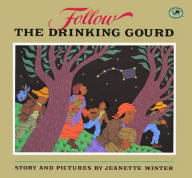Interpretation Over the
Last Twenty Years
Planetarium Show and Supporting Materials
In 1988, author Jeanette Winter turned the song into a well-received
children's book. In 1995, this book formed the narrative core of a
planetarium show co-produced by the New Jersey State Museum Planetarium
and the Raritan Valley Community College Planetarium. It
told the Jeanette Winter story and added considerable additional
material on astronomy and interpreting the song.
The show was quite popular and is still shown regularly around the
country in February for Black History month. More importantly for our
purposes, the sponsoring Planetaria published an Educator's Guide by the
show's producer, Gloria Rall. In the Fall of 1998 the Madison Wisconsin
Metropolitan School District hosted a web version of the Educator's Guide.
The Madison site meticulously credited the source of its content, but
most other subsequent web versions did not. The print Guide thus provided the core content for the song's interpretation
on dozens if not hundreds of websites.
Problems
Unfortunately, the print Guide (and most references derived
from it) get a lot of
things wrong. They do not recognize Lee Hays's role in rewriting the
song, and therefore that the lyrics used in the Guide could not
have been sung by slaves. To take just one other example, here are the
lyrics of the first verse (as originally published in 1928):
When the sun come back,
When the firs' quail call,
Then the time is come
Foller the drinkin' gou'd.
This verse was interpreted by Parks and all other commentators as
urging escapees to leave in the spring. The Educator's Guide suggested it means that escapees should
leave in the winter. Here's why.
According to the Guide, "when the firs' quail call" means the
winter, when migratory quail return from the north and their call would
have been heard by slaves. The Guide goes on to explain that the
straight line distance from Mobile, Alabama to the confluence of the
Ohio and Tennessee Rivers is 800 miles and that escaping slaves would
need a year to travel that far. And last, that this would put them at
the Ohio the following winter, when the river would be frozen and
therefore easier to cross. Taking all these factors together, according
to the Guide, the Underground Railroad suggested a winter escape.
NASA's website states (without attribution!): "The Railroad struggled
with the problem of how to get escapees across, and with experience,
came to believe the best crossing time was winter. Then the river was
frozen, and escapees could walk across on the ice. Since it took most
escapees a year to travel from the South to the Ohio, the Railroad urged
slaves to start their trip in winter in order to be at the Ohio the next
winter."
Rebuttal
Here's the rub. First, American quail are not migratory
(1) They
don't return to Alabama from the north, but stay in the region
year-round. They start calling to each other at the start of the spring
breeding season in early to mid-April, not in the winter after returning
from an imaginary migration.
Second, the straight line distance from Mobile to Paducah is 440
miles, not 800.
Third, the estimate of a year's travel time is drawn from the
testimony of exactly one slave. (I examine how this one account
somehow came to stand for all slaves escaping northward from the Deep South
here.)
Fourth, we know that the Ohio did not freeze every winter.
Fifth, the Guide makes it sound as if the Underground Railroad
had a Board of Directors meeting, decided on the best time of the year
for slaves to escape, and then put an action plan in place. Of course,
the Underground Railroad did not function that way.
Last, we know that slaves escaped year round, based more on the
opportunity than the season.
(2)
Impact of the Educator's Guide
In the absence of almost any other research into the Drinking
Gourd song – and a high level of interest – the
Educator's Guide and web versions quoting or paraphrasing it filled a void. Quotations from the Guide and
rewrites of its contents appear not only in NASA's website but also
on many others originating from Maine to Singapore. Material
from the Guide has found its way into books, and is incorporated into
the song's interpretation at the National Underground Railroad Freedom
Center. And virtually none of these websites and references indicate
that their lyrics date from the mid-20th century.
|